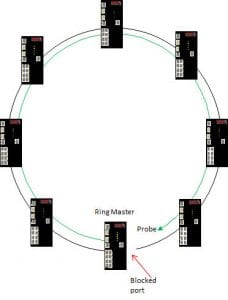Introduction to X-Ring Plus Ethernet Industrial Ring Technology
What is X-Ring plus resilient ring technology?
The original X-Ring as supplied on the Case Communications range of industrial Ethernet switches provides a greatly improved re-routing time in the event of a failure over spanning tree and rapid spanning tree.
X-Ring plus resilient ring technology is provided with network operating system 2.0 and is an enhanced version of Case Communications ‘X-Ring’ technology, which provides high levels of resilience in industrial ring networks.
Typically re-routing times of 6m to 10ms can be achieved and networks can be as large as 250 switches per ring, with a number of topologies allowing Ring to Ring connectivity and dual head end operation.
An Overview of the key features of X-Ring plus resilient ring technology are;
1. Extended number of switches per ring Previously the maximum number of switches per ring were 50, with X-Ring+ its now possible to have up to 250 switches per ring.
2. Quicker re-routing time X-Ring + uses a new algorithm to reduce link failure detection time and to re-route the data faster. Typically recovery is 10ms, in a network a network of 250 switches.
3. Extended Topologies X-Ring+ allows up to 99 rings to be inter-connected increasing the scale of the network and improving flexibility
4. Inter-connectivity For connection to ‘Head End’ switches we can use X-Ring+, Dual Homing and Ring coupling as well as more standard methods of interworking with third part products such as use of RSTP. The terminology has changed form ‘Dual Homed’ switches to RSTP.
5. Chaining of rings Chaining of X-Ring+ networks allows two rings to share a number of switches which can reside on both rings.
6. Easier Configuration With X-Ring+ there is no longer any requirement to configure a ‘Ring Master’ the network will automatically configure its own master, by selecting the last switch to be connected to the ring, as the master.
7. Is it necessary to purchase new hardware to run X-Ring+ Existing products can be upgraded to X-Ring+ via a software upgrade.
8. Is X-Ring+ compatible with X-Ring? X-Ring+ is completely compatible with X-Ring, via selecting a menu option to either run X-Ring or X-Ring+.
A more detailed explanation of X-Ring +
X-Ring is supplied on the Case Communications range of Industrial Ethernet switches and provides an improvement over Spanning Tree and Rapid Spanning Tree.It provides a very rapid auto recovery if the network suffers a corrupt or broken link and prevent network loops.Case Communications X-Ring provides an Ethernet Ring between Industrial Ethernet switches, running at 10 Mbps, 100 Mbps or 1 Gbps.X-Ring can support up to 50 switches within a single Ring with a re-route time of under 30 milli-seconds, while X-Ring+ can support up to 250 switches, with a re-route time of under 10milli-seconds.The Rings geographic distance is only limited by the Fibre modules fitted to the switches so if using Single Mode SFPs capable of 140 km for example we could see a Ring of more than 35,000 km.When using copper then normal Ethernet rules apply.Multiple Rings can be connected using ‘Head-End’ Ethernet switches, and ring coupling.
X Ring + Theory of Operation
When an Ring+ network is constructed one of the switches in the Ring has to block the Ethernet loop, and this switch is known as the ‘Ring Master’.Previously the Ring master was configured manually and it was possible to have several ring masters, with the switch with the lowest MAC address assuming the role of ‘Ring Master’.This ‘Ring Master’ would send out an X-Ring BPDU (Bridge Protocol Data Unit) from one of its ports and this would travel around the network and be blocked by the Rings Masters second Ring Port.With X-Ring+ its no longer necessary con configure a switch as Ring master, all switches will pass the traffic through, but the last switch to be connected will automatically detect a loop and its port with the lowest MAC address will automatically block traffic, and that switch will become the Ring master.The switches will only send an X-Ring BPDU out when it detects a link up or link down on its own switch, hence there is no longer any packet continually travelling round the ring.The Ring Master sends out a packet onto the Ring to say, ‘Link Up’, and if this packet is received on the ‘Ring Master’ second ring port, the Ring Master knows there is a loop in the network and will therefore block the port which received the X-Ring BPDU packet.
Why don’t we need to set a ‘Ring Master’ with X-Ring + ?
As an X-Ring is not complete until the last switch is connected, by default the last switch in the network to join and complete the ring becomes the ‘Ring-Master’.Diagram 1 below depicts a normal healthy ring operation.


